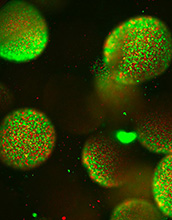Environmental structure affects interactions among microbial species

These different species of bacteria are thriving thanks to their structured environment.
Researchers at Duke University have uncovered a basic but surprising fact: A kitchen sponge is a better incubator for diverse bacterial communities than a laboratory petri dish. But it's not just the trapped leftovers that make the cornucopia of microbes swarming around so happy and productive, it's the structure of the sponge itself.
In a series of experiments, the scientists show that various microbial species can affect one another's population dynamics depending on structural environment factors such as complexity and size. Some bacteria thrive in a diverse community while others prefer a solitary existence. And a physical environment that allows both to live their best lives leads to the strongest levels of biodiversity.
Soil provides that optimal mixed-housing environment -- and so does a kitchen sponge.
The Duke biomedical engineers say their results suggest that structural environments should be considered by industries that use bacteria to accomplish tasks such as cleaning up pollution or producing commercial products.
The U.S. National Science Foundation-supported results appeared in the journal Nature Chemical Biology.
"Bacteria are just like people living through the pandemic -- some find it difficult being isolated while others thrive," said Lingchong You, a biomedical engineer at Duke. "We've demonstrated that in a complex community that has both positive and negative interactions between species, there is an intermediate amount of integration that will maximize its overall coexistence."
Microbial communities mix in varying degrees in nature. Soil provides many nooks and crannies for different populations to grow without much interaction from their neighbors. The same can be said for individual droplets of water on the tops of leaves.
But when humans throw many bacterial species together into a structureless goop to produce commodities like alcohol, biofuel and medications, it's usually on a plate or even in a vat. In their experiments, You and his laboratory show why these industrial efforts might be wise to begin taking a structural approach in their manufacturing efforts.
"As it turns out, a sponge is a very simple way to implement multilevel portioning to enhance the overall microbial community," You said. "Maybe that's why it's a really dirty thing -- the structure of a sponge makes a perfect home for microbes."






